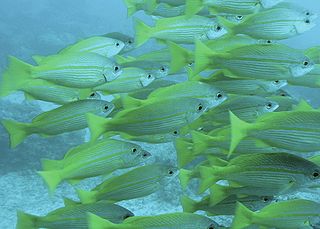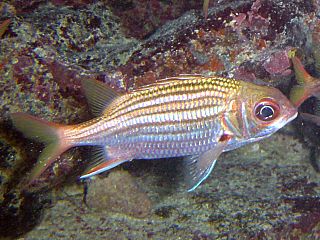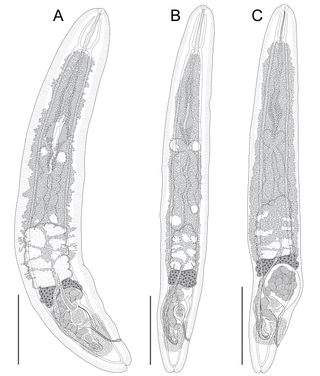
Acanthurus is a genus of marine ray-finned fish belonging to the family Acanthuridae, which includes the surgeonfishes, unicornfishes and tangs, found in the Atlantic, Indian and Pacific Ocean. They are found in tropical oceans, especially near coral reefs, with most species in the Indo-Pacific but a few are found in the Atlantic Ocean. As other members of the family, they have a pair of spines, one on either side of the base of the tail which are dangerously sharp.

Chromis is a genus of fish in the family Pomacentridae. While the term damselfish describes a group of marine fish including more than one genus, most damselfish are in the genus Chromis. These fish are popular aquarium pets due to their small size, tolerance for poor water quality, and bright colors, though their lifespans tend to be shorter than other fish.

Trypanorhyncha is an order of cestodes, a type of flatworm.

Sargocentron is a genus of squirrelfish found in tropical parts of the Indian, Pacific and Atlantic Oceans, with the greatest species diversity near reefs in the Indo-Pacific. Being largely or entirely nocturnal, they have relatively large eyes. Red and silvery colours dominate. The preopercle spines are venomous and can give painful wounds. Most have a maximum length of 15–25 cm (6–10 in), but S. iota barely reaches 8 cm (3 in), and S. spiniferum can reach more than 50 cm (20 in).

Myripristis is a genus of soldierfishes.

Prognathodes is a genus of butterflyfish in the family Chaetodontidae. They are found at rocky reefs in tropical oceans around the world and are mainly found deeper than Chaetodon; often a depths below those possible in normal scuba diving. In the past they were commonly included in the genus Chaetodon. They are whitish, yellow, black and dark brown, and reach 10–16 centimetres (3.9–6.3 in) in length.

Mugil is a genus of mullet in the family Mugilidae found worldwide in tropical and temperate coastal marine waters, but also entering estuaries and rivers.

Halichoeres are a genus of wrasses found in the Atlantic, Indian and Pacific Oceans.

Lutjanus is a genus of marine ray-finned fish, snappers belonging to the family Lutjanidae. They are found in the Atlantic, Indian, and Pacific Oceans. They are predatory fish usually found in tropical and subtropical reefs, and mangrove forests. This genus also includes two species that only occur in fresh and brackish waters.

The longspine squirrelfish is a silvery red, sea fish with orange-gold body stripes. One of about 150 species of squirrelfish, their most distinguishing characteristics are their large eyes and the long third spine of the anal fin. It is often included in public aquarium displays. The length of the longspine squirrelfish is about 18 cm. It lives in coral reefs in tropical and warm temperate seas and eats zoobenthos. It is territorial and uses sounds called "grunts" and "staccatos" to defend its crevice, warn of danger and, in groups, intimidate predators such as the moray eel. The longspine squirrelfish is edible and harvested on a small scale.

Luzonichthys is a genus of marine ray-finned fish in subfamily Anthiinae of the family Serranidae, the groupers and sea basses.

Neoniphon opercularis, the blackfin squirrelfish, also known as the mouth-fin squirrelfish or clearfin squirrelfish, is a species of squirrelfish found in the Indian Ocean and Pacific Ocean from East Africa as far east as New Caledonia. It lives alone or in small groups in or near reefs and lagoons between 3 and 25 metres deep and can reach sizes of up to 35.0 centimetres (13.8 in) TL. It eats crabs and shrimps. Its dorsal fin is raised to scare off or startle predators. It also has a large venomous spine at the corner of its preopercle. It is relatively unaffected by commercial fishing, but is sometimes used as bait for tuna fisheries.

Neoniphon sammara, the sammara squirrelfish, also known as the blood-spot squirrelfish, slender squirrelfish, spotfin squirrelfish, armed squirrel-fish or javelin squirrelfish, is a species squirrelfish found in the Indian Ocean and Pacific Ocean from East Africa to the Hawaiian Islands. It feeds on shrimps and small crabs and fish at night and can grow up to 32.0 centimetres (12.6 in) TL in length, though its common length is only 23.0 centimetres (9.1 in) TL. Like N. opercularis, it has a venomous spine on its preopercle.

Neoniphon marianus, also known as the longjaw squirrelfish, is a species of squirrelfish found in the Western Atlantic Ocean from the Florida Keys south to Trinidad and throughout the Caribbean Sea. It lives near reefs at depths between 1 and 70 metres, usually between 30 and 60 metres, and can reach sizes of up to 18.0 centimetres (7.1 in) TL. It is nocturnal and consumes mostly shrimps, but will also eat crabs.

Tosanoides is a genus of marine ray-finned fish in the subfamily Anthiinae which is part of the family Serranidae, the groupers and sea basses. They are found in the Atlantic and Pacific Ocean.

Neoniphon argenteus, the clearfin squirrelfish or silver squirrelfish, is a seldom-seen member of the family Holocentridae. It is native to the Indian Ocean and Pacific Ocean from East Africa to New Caledonia. It is also found both north and south of Australia and throughout Micronesia. It lives mainly around islands and shallow reefs, and like N. sammara is associated with Acropora corals. Its depth range is 3–20 m (9.8–65.6 ft) and it can reach sizes of up to 24.0 cm (9.4 in) TL. It feeds primarily on benthic invertebrates. It is found in the ornamental trade and can be used as bait in tuna fisheries, but there are currently no known major threats to the species.

Neoniphon aurolineatus, more commonly known as the yellowstriped squirrelfish or gold-lined squirrelfish, is a member of the family Holocentridae. It has a wide range throughout the Indian and Pacific Oceans stretching east from Mauritius to Hawaii and south from Japan to the Great Barrier Reef of Australia. It lives on the outer reef slopes at depths between 30 and 188 metres. It lives near the ocean floor or in caves, generally staying alone or in small groups. It feeds on crustaceans and can reach sizes of up to 25.0 centimetres (9.8 in) TL. It is listed as "Least Concern" by the IUCN due to its deep-water habitat and lack of known major threats.

Diplectrum, commonly known as sand perches, is a genus of marine ray-finned fishes which is a member of the subfamily Serraninae of the family Serranidae, which includes the groupers and anthias. There are 12 species distributed in the western Atlantic Ocean and the eastern Pacific Ocean.
Neoniphon pencei, or Pence's squirrelfish, is a species of squirrelfish found in the Pacific Ocean in Rarotonga, Cook Islands and Mo'orea, French Polynesia. It differs from other species of the genus Neoniphon in number of lateral line scales, scales above and below lateral line, elements of life colour, and in COI and cytochrome b DNA sequences.

Holocentricola is a genus of digeneans in the family Aporocotylidae or blood flukes, described in 2021. The name of the genus refers to the host fish, which are members of the family Holocentridae or squirrelfishes.



















